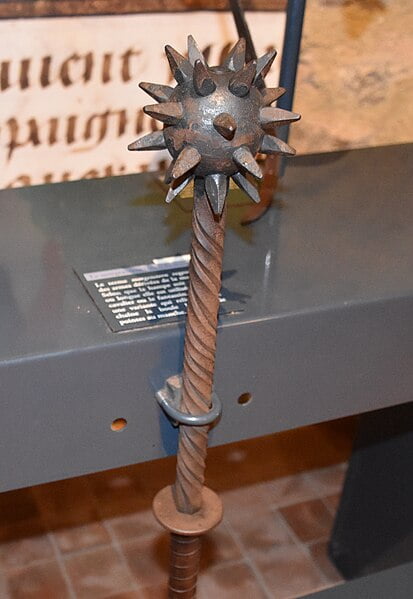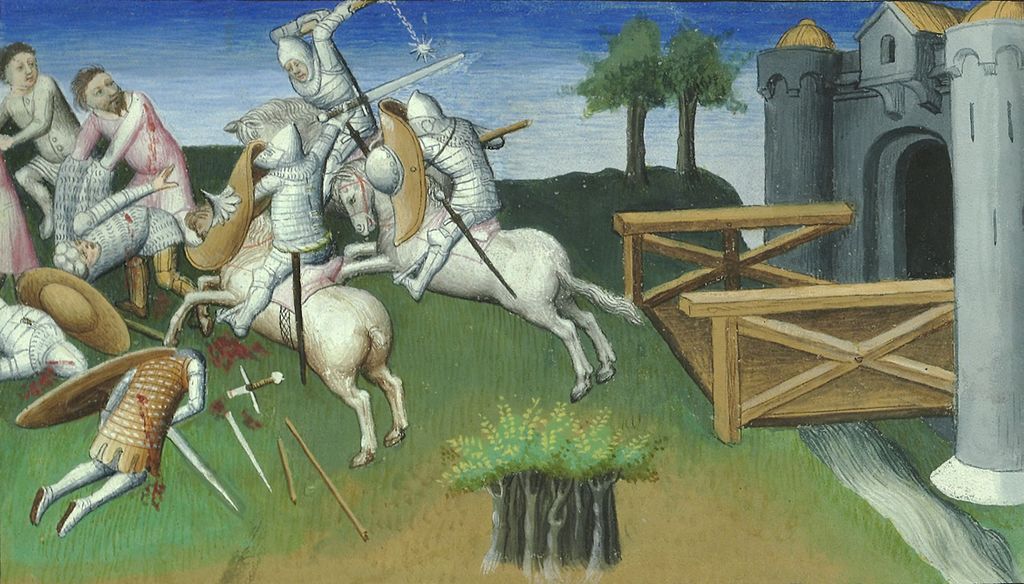Ever wondered how knights conquered in armor so tough it seemed unbreakable? Enter the morning star, a brutal medieval weapon designed to do just that. This post will swing you through history, revealing how this spike-studded mace smashed its way onto the battlefield and into legend. Discover a past as pointed as the spikes themselves!
Table of Contents
- 1 Different Types of Morning Star Weapons
- 2 Historical Significance and Use of Morning Star in Battle
- 3 Construction and Design Aspects of Morning Star Weapons
- 4 Similar Medieval Weapons
- 5 Conclusion: The Legacy and Cultural Impact of This Weapon
- 6 FAQs
- 6.1 1. What is a Morning Star weapon?
- 6.2 2. How was the Holy Water Sprinkler different from the Morning star?
- 6.3 3. Did knights use morning stars in battles or just for show?
- 6.4 4. Can you find real morning stars online or at stores like Amazon?
- 6.5 5. Are there modern uses for the design principles behind weapons like the Morning Star?
Different Types of Morning Star Weapons
Delve into the diverse arsenal of medieval morning stars, each variant uniquely adapted for battlefield supremacy. From the brutal efficiency of flanged models to the terrifying spikes and iconic ball-and-chain designs, these weapons were as varied as they were deadly.
Flanged Morning Star
The Flanged Morning Star stands out among medieval weaponry for its distinctive design. Crafted with protruding metal flanges, this variant delivered devastating blows to armored adversaries.
Blacksmiths engineered these flanges to concentrate the force of impact, making it possible for a foot soldier to dent or even puncture heavy plate armor. Swinging a Flanged Morning Star required both strength and skill — qualities that infantrymen honed through rigorous training.
This weapon’s efficacy wasn’t just in its ability to compromise armor but also in causing severe injury. Each strike aimed not just to disarm, but to disable opponents quickly and efficiently on the battlefield.
Warriors wielding this formidable armament played pivotal roles during clashes with French knights and at historic engagements like the Battle of Courtrai. Next up, we’ll take a closer look at another menacing version: the Spiked Morning Star.
Spiked Morning Star

Moving from the flanged design, the spiked Morning Star introduces a more brutal approach to medieval warfare. English foot soldiers in the sixteenth century often wielded this menacing weapon, with its heavy spiked ball capable of delivering devastating puncture attacks.
Unlike swords or lances that required precision and skill, the Morning Star relied on raw power. Its wooden handle provided a sturdy grip for swinging at armors and chain mail with force enough to break bones.
Crafting a Spiked Morning Star was no simple task. Blacksmiths had to balance weight and lethality, resulting in models that could reach up to 12 pounds. This made every strike a considerable effort but also ensured that even glancing blows would leave enemies reeling from severe wounds.
Soldiers needed both hands to manage its heft effectively during cavalry charges or tight infantry clashes where maces and flails were common sights. Despite its weight, those who mastered it found they could control battlefield dynamics by keeping adversaries at bay with fear of its crushing impact.
Ball-and-Chain Morning Star
The Ball-and-Chain Morning Star stood out for its ability to strike from a distance, keeping the fighter safely away from an enemy’s blade. This weapon demanded both physical strength and dexterity, which meant that only the most capable warriors could handle it with the necessary skill on the battlefield.
Swinging this weapon generated significant force, making it particularly effective against foes clad in armor.
Cavalrymen and foot soldiers alike favored this type of morning star because of how well it could pivot and move during combat. The long chain allowed for a wide range of attack angles, difficult for opponents to predict or parry.
Its intimidating presence often featured in medieval depictions of battles – serving as a strong symbol for military might and knightly prowess amidst the chaos of war.
Historical Significance and Use of Morning Star in Battle
Morning stars cut through the medieval battlefields with their spiked heads and intimidating presence. Warriors valued this weapon for its effectiveness against enemies wearing plate armor; the spikes could puncture through metal defenses that typical swords struggled to damage.
Foot soldiers and mounted knights alike found morning stars simple to wield, needing less skill than a sword or lance, making them popular among various ranks. Infantry units often used them in tight formations, while cavalry wielded them on horseback to break enemy lines.

Unlike English longbowmen who required extensive training or pikemen who relied on coordinated tactics, those carrying morning stars were quick to join the fray and able to adapt spontaneously during skirmishes.
During significant conflicts such as the Battle of the Golden Spurs in 1302, the morning star played a pivotal role. Soldiers equipped with these weapons helped defeat French cavalry, proving their worth in combat situations where mobility and adaptability were crucial.
This ease of use combined with lethal efficiency cemented the morning star’s reputation as a formidable tool of war throughout medieval Europe.
Construction and Design Aspects of Morning Star Weapons
Crafting a Morning Star was as much an art as it was a skill, with blacksmiths often customizing these weapons to suit the wielder’s needs. They employed robust materials such as iron or steel for the head, ensuring it could withstand fierce combat and deliver devastating blows.
The spikes, crucial for piercing armor, varied in number and length but were always sharp and sturdy, capable of inflicting significant damage.
Design features of these lethal implements ranged from simple spiked balls to more intricate shapes like stars—hence the name “morning star.” Handles were typically made from wood or metal and designed for balance and grip.
Some featured chains connecting the weapon’s head to the handle, adding flexibility and reach in battle—a design known as a kettenmorgenstern or ball-and-chain flail. This variety allowed fighters to personalize their morning stars according to their tactics and preferred fighting style.
Similar Medieval Weapons
The Morning Star wasn’t the only formidable medieval weapon designed to crush and penetrate armor. Many similar arms competed on the ancient battlefields, each with their unique characteristics.
- War Hammer: Like the Morning Star, war hammers had a hardened head meant for smashing through armor. However, they often featured a spike on one side for piercing, and a hammerhead on the other for blunt force.
- Mace: The mace shared its origins as a club, like the Morning Star. Typically made of solid metal, it had a heavy head with flanges or knobs to deal devastating blows but lacked spikes.
- Flail: Sharing similarities with the ball-and-chain version of the Morning Star, flails had one or more heads attached by chains. They allowed knights to swing at opponents from behind their own shield.
- Halberd: This two-handed polearm combined spear-like thrusting with an axe blade and oftentimes a hook or thorn for grappling enemies or their mounts, diversifying its attacking maneuvers in contrast to the focused impact of the Morning Star.
- Goedendag: A simple yet effective spiked staff weapon used by Flemish infantry during the Battle of the Golden Spurs (Guldensporenslag), goedendags were dual-purpose, acting both as a spear and as a bludgeoning club when swung.
Where can I find medieval morning stars on display?
You can visit these institutions if you want to see some perfectly preserved medieval morning stars.
| Institution | Location | Description |
| Horniman Museum and Gardens | London, UK | An Indian morning star with a concealed dagger. |
| Dutch Fortress Museum Maastricht | Maastricht, the Netherlands | A morning star of unspecified origin. |
Conclusion: The Legacy and Cultural Impact of This Weapon
Discovering the morning star opens a window into medieval combat and culture. These weapons, with their menacing spikes, tell tales of battles fought and armor thwarted. Warriors wielded them with brutal efficiency, shaping the outcomes of key historical moments.
Today, they spark fascination in museums and reenactments alike, where we can almost hear the clash of metal echoing through time. Morning stars remain emblematic relics that continue to captivate those exploring the rich tapestry of medieval history.
FAQs
1. What is a Morning Star weapon?
A Morning Star is a medieval weapon with spikes attached to the top of a club, resembling a mace-and-chain. It was used by warriors for combat against armor.
2. How was the Holy Water Sprinkler different from the Morning star?
The Holy Water Sprinkler is another name for certain types of military flails, including some that looked similar to morning stars, but it mainly refers to weapons that were designed more like a mace with spiked heads.
3. Did knights use morning stars in battles or just for show?
Knights and Swiss mercenaries actually used morning stars in battle during medieval times; they weren’t just symbols of medieval chivalry or only used in reenactments today.
4. Can you find real morning stars online or at stores like Amazon?
Yes, replicas of historical morning stars can be purchased through online retailers such as Amazon for collection or educational purposes.
5. Are there modern uses for the design principles behind weapons like the Morning Star?
While not used as weapons anymore, the design principles behind them influence areas like welding tools and even designs seen on social media networks’ personalization features.
